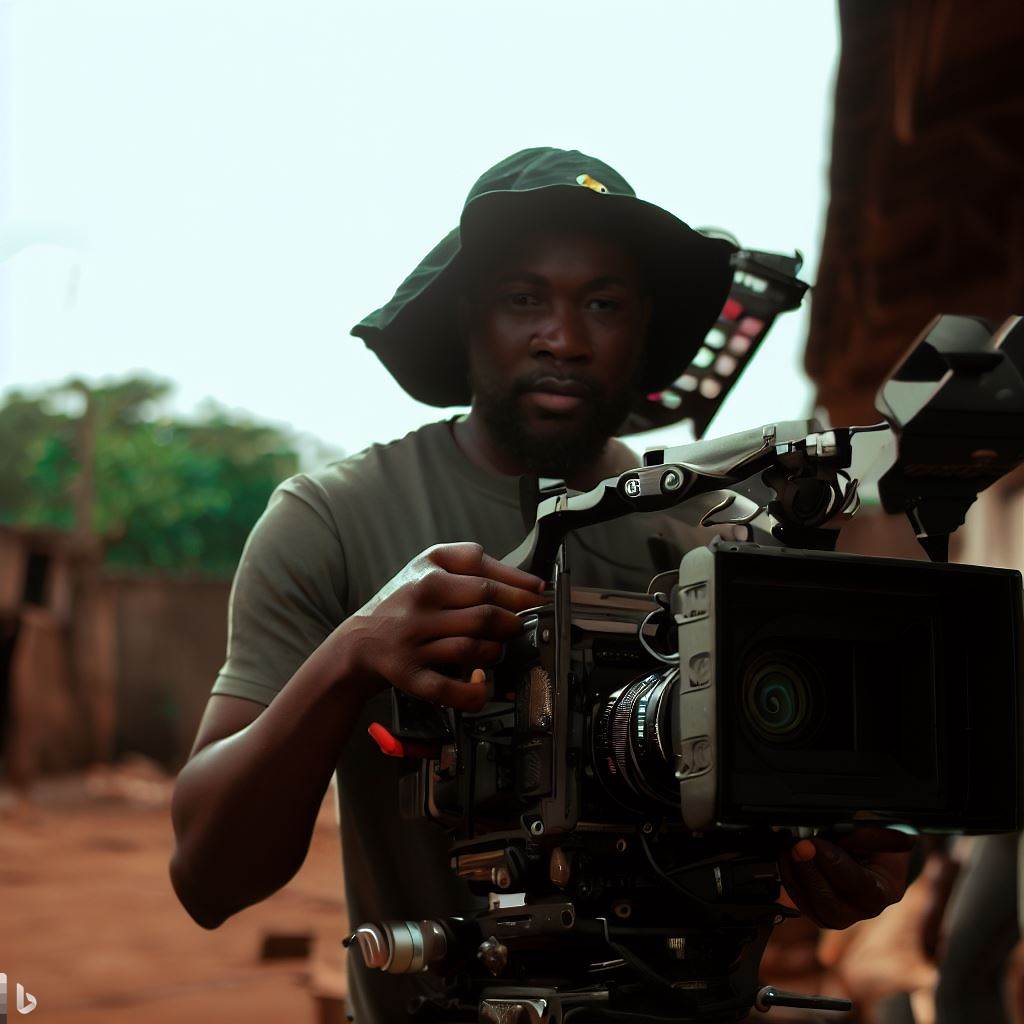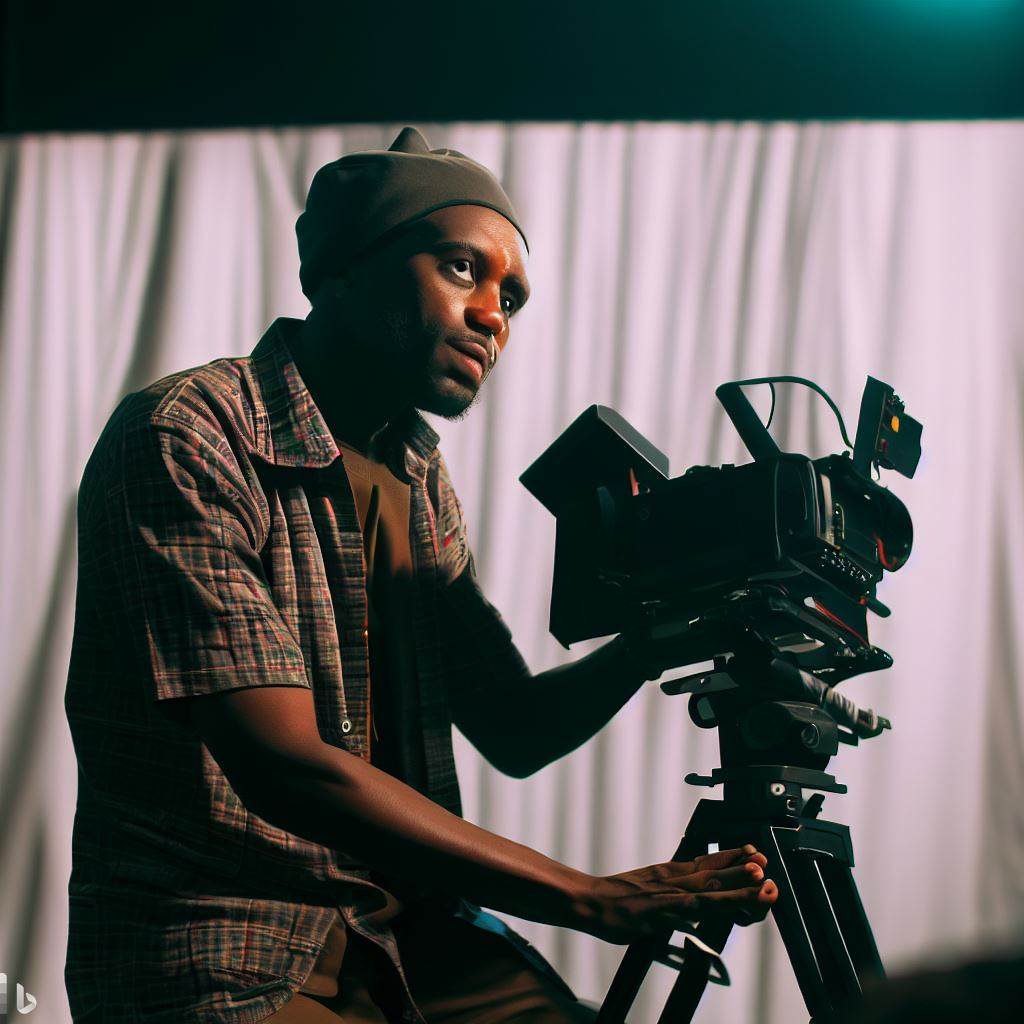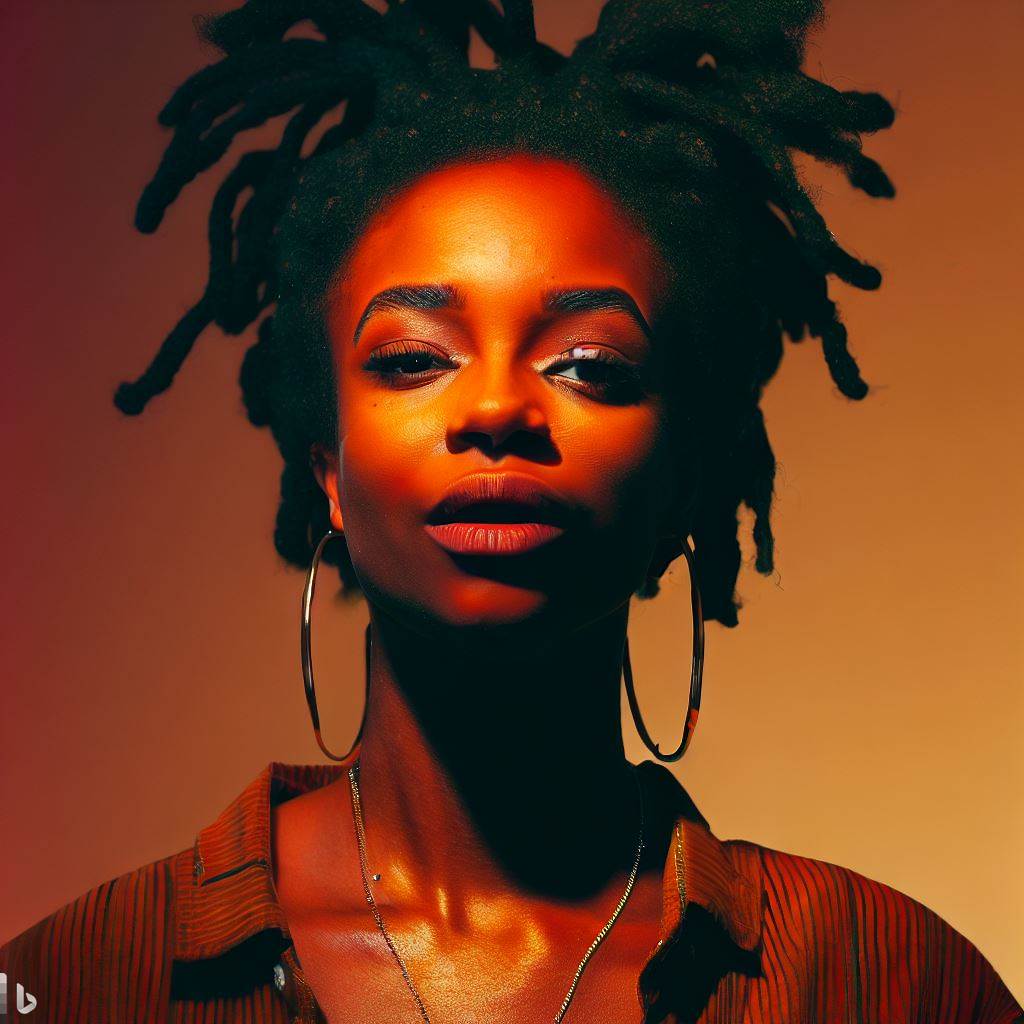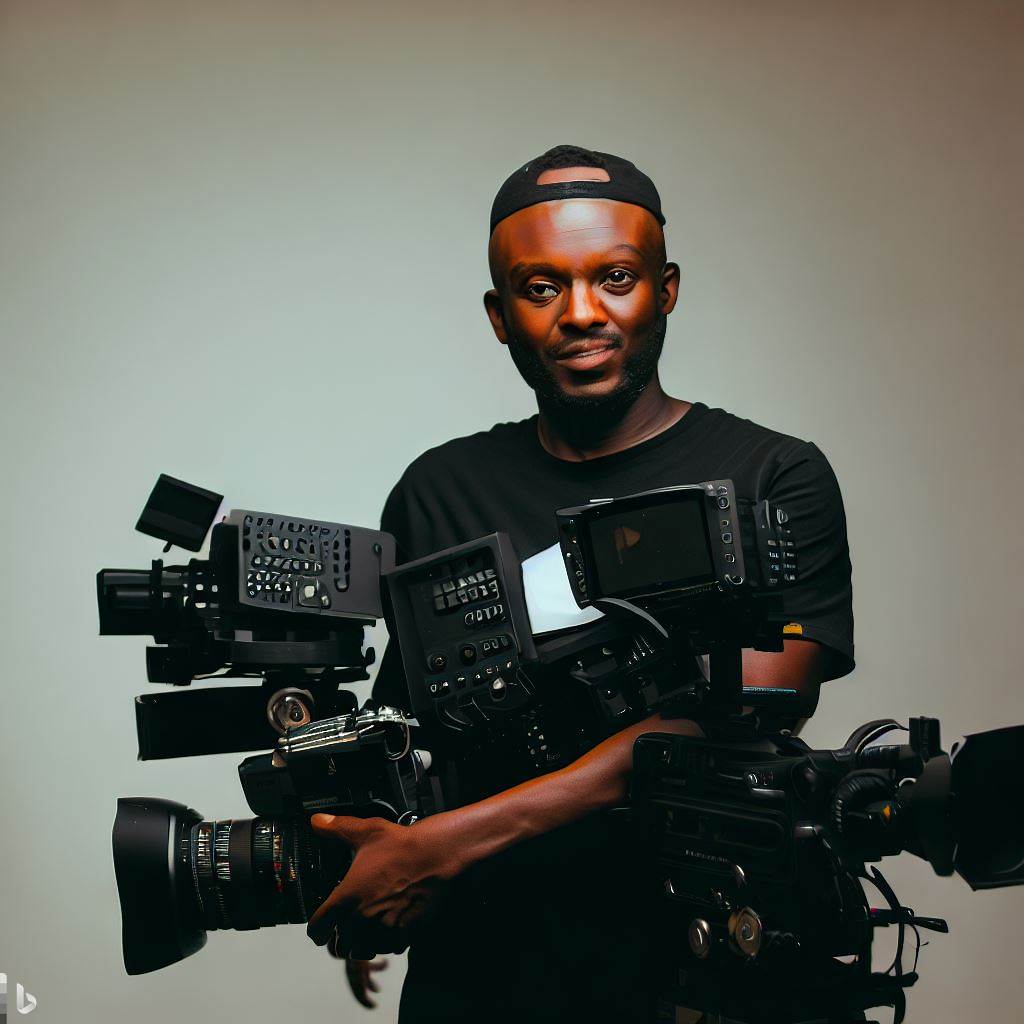Introduction
Cinematography plays a crucial role in Nigerian cinema, allowing filmmakers to bring their stories to life on screen. This article will look at Nigerian Cinematographer Life
Importance of cinematography in Nigerian cinema
Why is cinematography important in Nigerian cinema?
Cinematography in Nigerian cinema is vital as it enhances the visual storytelling experience, captivates audiences, and adds depth to narratives.
The use of lighting, camera angles, and composition helps create the desired mood and atmosphere.
It aids in conveying emotions and emphasizing key moments within a scene.
Furthermore, cinematography adds a layer of professionalism to Nigerian films, elevating the overall quality and appeal.
In addition, cinematographers in Nigeria contribute significantly to the growth and development of the industry.
They ensure that each frame is aesthetically pleasing and visually compelling, contributing to the overall success of a film.
Their expertise and technical skills help filmmakers in effectively communicating their intended message.
Cinematographers in Nigeria face numerous challenges, including limited resources and budget constraints.
However, their perseverance and creativity enable them to overcome these obstacles and produce exceptional work.
Cinematography is an essential element of Nigerian cinema. It enhances storytelling, creates captivating visuals, and helps elevate the overall quality of films.
Despite the challenges faced by cinematographers, their contributions to the industry are invaluable and continue to shape the Nigerian film landscape.
Overview of a Cinematographer’s Role
A cinematographer plays a crucial role in film production, as they are responsible for capturing the visual aspects of a movie.
Their expertise enables them to create the desired mood, tone, and atmosphere for a film, thereby enhancing the storytelling process.
Responsibilities of a Cinematographer
- Planning and collaborating with the director to understand their vision for the film.
- Selecting the appropriate camera equipment, lenses, and lighting setups for each scene.
- Working closely with the production design team to ensure visual consistency throughout the film.
- Setting up the camera angles, movements, and framing to convey the desired emotions and perspectives.
- Operatng the camera during shooting, adjusting focus, exposure, and composition for optimalresults.
- Managing the lighting setup, including natural and artificial sources, to create the desired mood.
- Overseeing the camera crew, directing their actions, and ensuring smooth operation on set.
- Collaborating with the editing team to ensure a seamless transition between shots and scenes.
- Staying updated with the latest technological advancements in cinematography tools and techniques.
Skills Required for Cinematography
Being a proficient cinematographer requires a combination of technical knowledge and artistic sensibilities. Some essential skills include:
- Strong understanding of composition, framing, and visual storytelling.
- Excellent knowledge of cameras, lenses, filters, and other cinematography equipment.
- Ability to manipulate lighting to create different moods and atmospheres.
- Keen attention to detail and a meticulous approach to achieve desired visual results.
- Good communication and collaboration skills to work effectively with the director and production team.
- Problem-solving abilities to tackle unexpected challenges during shoots.
- Flexibility and adaptability to work in different locations and under varying conditions.
- Creativity and innovation to bring fresh perspectives to visual storytelling.
Impact of Cinematography on Storytelling
Cinematography has a significant impact on storytelling, as it visually communicates the narrative and evokes emotions within the audience.
Through camera movements, lighting, and composition, a cinematographer crafts the visual language of the film, enhancing the overall cinematic experience.
By skillfully capturing the action, a cinematographer can immerse the audience in the world of the film. making them feel connected to the story and its characters.
Through creative framing and camera techniques, they can convey the characters’ thoughts, emotions, and intentions, adding depth and nuance to the narrative.
Cinematography also sets the tone and atmosphere of a film.
By manipulating lighting and color, a cinematographer can create a sense of mystery, suspense, or romance, influencing the audience’s emotional response.
Additionally, the choice of camera angles and movements can emphasize specific elements within a scene, guiding the viewer’s attention and emphasizing particular story points.
A cinematographer’s role in film production is vital for the success of a movie.
Cinematographers bring a story to life, enhancing storytelling and engaging the audience through technical expertise, artistic sensibilities, and director collaboration.
A Typical Day in a Nigerian Cinematographer’s Life
Meet Femi Ajayi, a professional Nigerian cinematographer known for his exceptional skills and versatility.
Every day, Femi’s routine begins with a cup of hot coffee to kick-start his creative energy.
One of the biggest challenges he faces is the constant struggle to maintain a work-life balance.
Femi works on a wide range of projects, from feature films and music videos to commercials and documentaries.
Each project requires Femi to adapt his cinematography style to suit the story and director’s vision.
Transform Your Career in Nigeria
Discover unmatched expertise with our personalized Career Consulting service. Navigate Nigeria’s job market with a strategy tailored just for you.
Get StartedCollaboration is a key aspect of Femi’s work, as he closely collaborates with directors, producers, and crew members.
During pre-production, Femi meets with the director to discuss the visual aesthetic and mood of the project.
They analyze the script, storyboard, and make important decisions regarding shot angles, lighting, and camera movements.
When shooting begins, Femi operates the camera and works closely with the director to capture the desired shots.
He meticulously manipulates lighting conditions to create the perfect ambiance for each scene.
Femi’s primary goal is to enhance the story and evoke emotions through his cinematography.
While shooting, he is always mindful of the technical aspects, such as exposure, focus, and composition.
Long hours on set can be physically and mentally demanding, but Femi thrives in such challenging environments.
He enjoys the adrenaline rush of capturing the perfect shot and witnessing the story come to life.
After a day of shooting, Femi spends time reviewing and selecting the best footage.
He also collaborates with the editing team to ensure the final product meets his artistic vision.
Read: Animation Directing: Nigeria vs. The Global Scene
Preparation Phase
Before a shoot, a cinematographer takes several initial steps to ensure a successful production.
Understanding the Script and Director’s Vision
- The cinematographer reads the script thoroughly to grasp the story’s essence and visual requirements.
- They have discussions with the director to understand their vision, style, and desired emotional tone.
Creating a Visual Storyboard and Shot List
- The cinematographer collaborates with the director to create a visual storyboard.
- They sketch or use software to illustrate each shot, ensuring a clear visual representation of the film.
- A shot list is created, specifying the order and details of each shot, guiding the production team during filming.
Selection of Camera Equipment and Lighting Setup
- Based on the visual requirements, the cinematographer selects the appropriate camera equipment.
- Different camera types, lenses, filters, and accessories are carefully chosen to achieve the desired visual aesthetic.
- The cinematographer plans the lighting setup, deciding on the type, intensity, and positioning of lights to enhance the mood.
These behind-the-scenes activities during the preparation phase play a vital role in the overall success of a shoot.
On Set Experience
As a cinematographer, the role during the actual filming process is crucial in capturing the desired visuals.
The Cinematographer’s Role
- Setting up the camera, adjusting settings, and ensuring the technical aspects are in order.
- Collaborating closely with the director to understand their vision and translate it into visuals.
- Working alongside the production designer to create a cohesive visual style.
- Communicating with the camera crew to ensure smooth operation and coordination.
Coordination with Other Crew Members and Actors
- Collaborating with the production team to determine the shooting schedule and locations.
- Coordinating with the sound team to capture high-quality audio alongside the visuals.
- Working closely with the costume and makeup departments to ensure the visuals align with the narrative and characters.
- Guiding the actors on how to position themselves within the frame and interact with the camera.
Decision-Making Process regarding Camera Angles, Movements, and Framing
- Assessing the script and discussing shot ideas with the director to determine the best camera angles.
- Crafting dynamic camera movements that enhance the storytelling and evoke emotions.
- Experimenting with different framing techniques to create visually striking compositions.
- Making on-the-spot decisions to adjust camera positioning based on the actors’ movements.
Working with Lighting Technicians for Desired Visual Effects
- Collaborating with the gaffer and lighting technicians to create the desired atmosphere and mood.
- Determining the appropriate lighting setup to complement the scene’s emotional intensity.
- Utilizing various lighting techniques, such as key lighting and backlighting, to enhance the visuals.
- Ensuring proper exposure and balancing light levels to capture details in both bright and dark areas.
A Nigerian cinematographer’s day on set is filled with various responsibilities and collaborations.
They are the visual architects who bring the director’s vision to life through camera angles, movements, and framing.
By coordinating with other crew members and working with lighting technicians, they strive to achieve the desired visual effects and enhance the overall cinematic experience.
Read: Interpreter vs. Translator: Key Differences in Nigeria

Creative Problem-Solving and Adaptability
Cinematographers play a crucial role in bringing stories to life on the big screen.
Behind the scenes, they face numerous challenges in various shooting conditions, requiring them to be masters of creative problem-solving and adaptability.
Let’s delve into their world and explore how they overcome obstacles and adapt to unexpected situations.
One of the biggest challenges cinematographers face is working in unpredictable weather conditions.
Whether it’s scorching heat, pouring rain, or freezing temperatures, they must find ways to capture the desired shots while ensuring the safety of the cast and crew.
In such situations, they may need to improvise and adjust their plans on the spot.
For instance, imagine a scene set in a rainy forest. The cinematographer had envisioned capturing the ethereal beauty of sunlight filtering through the raindrops.
However, on the shooting day, it starts pouring heavily, making it impossible to capture the desired lighting.
In this situation, the cinematographer might quickly search for alternative lighting sources, like artificial lights or reflectors, to recreate the desired effect.
Another challenge faced by cinematographers is shooting in tight spaces.
Whether it’s a cramped apartment or a narrow alleyway, they must find ways to maneuver their equipment and capture the shots without compromising the storytelling.
This often requires them to think outside the box and adapt their shooting techniques.
Consider a scene where the protagonist is trapped in a small elevator.
To capture the intensity of the moment, the cinematographer must find innovative ways to frame the shots, utilizing different camera angles and lenses.
Read: Freelance vs Full-Time: Sound Editing Careers in Nigeria
Discover More: Nollywood Cinematography: A Blend of Tradition and Modernity
Publish Your Professional Profile, Business or Brand
Showcase your expertise, gain trust, and boost visibility instantly on Professions.ng.
Publish NowPost-Production Phase
Once the filming is completed, the role of a cinematographer doesn’t end there. They play a crucial role in the editing process, ensuring that the visual style and narrative of the film are achieved.
1. The Role of the Cinematographer in the Editing Process
The cinematographer works closely with the film editor to select the best shots and create a cohesive story.
They review all the footage and provide input on which shots to use, considering factors like lighting, composition, and camera movement.
By actively participating in the editing process, the cinematographer ensures that the director’s vision and the intended visual style are maintained throughout the film.
2. Collaborating with the Film Editor to Achieve the Intended Visual Style
The cinematographer collaborates with the film editor to achieve the intended visual style by providing guidance on color grading, contrast, saturation, and other aspects of post-production.
They work together to create a consistent and cohesive look that enhances the storytelling and evokes the desired emotions from the audience.
This collaboration is crucial to ensure that the final product reflects the cinematographer’s artistic vision.
3. The Use of Color Correction and Other Post-Production Techniques
Color correction is an essential post-production technique used to adjust the colors and tones of the footage.
The cinematographer, along with the colorist, fine-tunes the images to enhance the visual aesthetic and create the desired mood.
Additionally, the cinematographer may also collaborate with visual effects (VFX) artists to incorporate CGI elements seamlessly into the footage.
This ensures that the final result is visually stunning and in line with the overall vision of the film.
4. The Final Review and Approval Process
Before the film is considered complete, there is a final review and approval process where the cinematographer plays a vital role.
They carefully analyze the edited footage to ensure that it aligns with their original vision.
During this phase, the cinematographer provides feedback and notes to the film editor and colorist, ensuring that any necessary adjustments are made to achieve a cohesive final product.
This review process is crucial in maintaining the quality of the film and ensuring the cinematographer’s satisfaction.
The role of a cinematographer extends into the post-production phase.
Through their involvement, the cinematographer ensures that their artistic vision is translated onto the screen, resulting in a captivating and visually stunning film.
Read: The Impact of Nigerian Music Publishers on Artistes
The Importance of a Cinematographer’s Vision
In the world of cinema, the role of a cinematographer is often overshadowed by the director and actors.
However, their creative choices have a significant impact on the overall aesthetic and storytelling of a film.
A cinematographer’s vision is crucial in bringing a story to life through visuals.
1. Impact of Creative Choices on Aesthetic and Storytelling
- Cinematographers make decisions regarding lighting, camera angles, and composition that shape the mood and atmosphere of a film.
- Their choice of lenses, filters, and color grading techniques influence the visual style and tone, enhancing the narrative.
- By collaborating closely with the director, cinematographers translate the script into striking visuals that immerse the audience in the story.
- Through their artistry, cinematographers can capture the essence of a character’s emotions and intentions, adding depth to the storytelling.
- Their ability to manipulate visual elements allows them to emphasize key moments, create suspense, or evoke specific emotions.
2. Significance of Visual Storytelling in Nigerian Cinema
- In Nigerian cinema, visual storytelling plays a vital role in conveying cultural nuances and capturing the essence of the diverse society.
- Cinematographers have the power to showcase Nigeria’s vibrant landscapes, rich traditions, and unique perspectives through their lens.
- Visual storytelling in Nigerian cinema allows for the exploration of societal issues, historical events, and personal narratives.
- Through the use of visual symbols, colors, and framing, Nigerian cinematographers contribute to the authenticity and relatability of the stories.
- The visual language employed by cinematographers highlights the beauty, struggles, and aspirations of the Nigerian people.
3. Contribution of Cinematography to the Success of a Film
- A well-executed cinematography enhances the overall quality of a film and captivates the audience’s attention.
- By visually engaging the audience, cinematography ensures a memorable and immersive cinematic experience.
- The artistic choices made by cinematographers can elevate the storytelling and leave a lasting impact on viewers.
- Attention to detail in cinematography, such as framing, composition, and movement, heightens the audience’s emotional connection with the characters.
- A visually stunning film is more likely to attract viewers and gain recognition, contributing to its success at the box office and in film festivals.
The importance of a cinematographer’s vision should not be underestimated.
Their creative choices significantly impact the overall aesthetic and storytelling of a film.
In the Nigerian cinema industry, visual storytelling has immense significance as it allows for the exploration of cultural nuances and the portrayal of diverse perspectives.
Cinematography contributes to the success of a film by enhancing its quality, captivating the audience, and leaving a lasting impression.
Next time you watch a film, remember to appreciate the work of the cinematographer behind the scenes.
Find Out More: A Look at Local Languages in Nigeria’s Voice Acting Scene
Conclusion
The role of a cinematographer cannot be understated in the filmmaking process. They are responsible for capturing the visual essence of a film and bringing the director’s vision to life.
The unique challenges and rewards faced by Nigerian cinematographers add another layer of complexity to their work.
Despite facing limited resources and funding, Nigerian cinematographers find innovative ways to create visually stunning films.
They have to navigate power outages, extreme weather conditions, and even security concerns.
However, they also have the opportunity to showcase the rich cultural heritage and diverse landscapes of Nigeria.
It is important for readers to appreciate the behind-the-scenes efforts of cinematographers. Without their dedication and creativity, films would not have the same impact.
The time, effort, and attention to detail that goes into every shot deserves recognition.
Next time you watch a film, take a moment to reflect on the work of the cinematographer.
Appreciate the carefully crafted compositions, the use of lighting, and the movement of the camera.
By doing so, you can truly understand and acknowledge the significance of their contributions to the world of cinema.
Remember, without cinematographers, films would be just words on a page, and the magic of storytelling would be lost.




